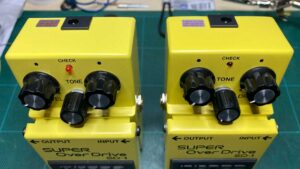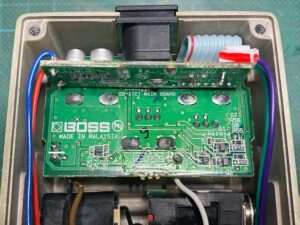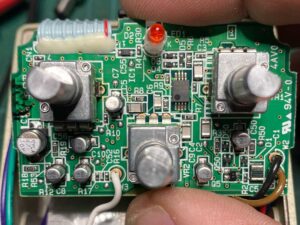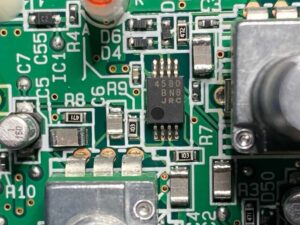So I bought one of the new Malaysian-made Boss Super Overdrive pedals – internally named SD-1(C) – to see for myself how it is built, and how hard it would be to use it as a base for modifications. I knew that the new circuit layout used surface-mounted components, but those come in all sorts of sizes, from relatively manageable all the way to nearly invisible.
From the pictures I already had seen, the part of the circuit board that was visible had some really small components, but I figured the other side – where the bulk of the circuit’s components would be located – might feature some of the larger ones. No such luck… 🙁 That side of the board was densely packed with super-tiny components, so there’s no way I’ll be able to do any mods to it. I can’t even begin to figure out how I would go about desoldering a component a third the size of my soldering iron’s tip, while picking it up with tiny tweezers (all without disturbing its neighbours). And then doing it all in reverse, to get the new component in. No thanks…
But even so, I thought I’d do a write-up on the pedal, as it is part of the new Boss design brief. And of course to help anyone who wants to be able to tell what version of the SD-1 they’re looking to buy…
Exterior clues
In the ”Changes at Boss” article, I did mention that the new SD-1 might be hard to visually spot, compared to the older one, since it has used the same adapter jack style throughout. I also mentioned a few other hints visible from the outside, but in case you need a reminder, let’s start there. First of all, the bottom plate is different, and says ”Made in Malaysia” – that is a dead giveaway. But there are other clues as well.
The LED is different – it is actually a clear LED that lights up red, rather than the diffused red LED of the earlier version. The LED also sits lower, so it doesn’t stick up as much above the face of the pedal. The paint is different too – on the new version, the paint is a slightly deeper yellow hue, and has a texture to it. You can see the texture in the image, if you click it to zoom in. It will show up even clearer in this picture of the old vs new SD-1.
The knobs look the same as they always have, but now the pots have D-shafts rather than being knurled.
These external clues are specifically for the SD-1(C), but most of them will apply to the other redesigned Boss pedals too. The early DS-1(B) and BD-2(B) were made in Taiwan rather than Malaysia, but otherwise share the same design cues.
Inside the pedal
Looking inside, we can see that the old circuit, which used to cover most of the pedal’s footprint, has been shrunk down to just the section beneath the control knobs. The adapter jack is soldered to a circuit board that houses the power and filtering sections to the left side, and the flip-flop circuit (very brief explanation: a pair of transistors that changes state as you step on the pedal, which in turn causes other transistors to mute or unmute parts of the audio circuit) to the right. That sub-board – which seems to be the same in all the redesigned pedals – is then connected to the main circuit board through a short ribbon cable.
Here’s a close-up of the flip-flop circuit, to the right of the adapter jack. Those transistors are decidedly tiny! Thankfully, this is not a part of the circuit that would normally be modified or repaired, but the tiny sized components does hint at what’s to come… And the power circuit – both sides of the board, to the left of the adapter jack – is actually the most probable place where repairs might be needed. Almost all cases where I’ve had to repair Boss pedals, the problem was power-related and due to a mishap with the wrong power adapter being used.
Flipping the board over to where the main audio circuit lives, we can see clearly the sheer tiny-ness of some of the components. And it’s not only that the components themselves are small – they are also quite close together. Granted, the worst (tightest) bits are on the power/switching board, while the main circuit board has a tad more space between components. Even so, getting in there with a soldering iron is not something I’d even want to attempt. So I definitely won’t be modding these.
The signal enters the board via the brown wire, bottom right. In that area we then find the input buffer stage. The clipping circuit – D4, D5, D6 – is located above the op-amp, near the status LED. This is well away from the input, so I figured chances were good that the ”bleed” issue the SD-1 has carried since its inception would finally be fixed. And it is – there is no bleed at all in bypass with the SD-1(C). One good thing, at least. The white wire, finally, carries the output signal to the output jack.
The SD-1 has never been associated with the same op-amp corksniffery as the Tube Screamer, so this bit might not be interesting. Or maybe it is. In any case, the SD-1 has always(?) used the JRC4558DD (rather than the ”holy grail” JRC4558D found in some of the original early ’80s TS-9’s), but in this latest iteration of the SD-1, they went for a JRC4580 instead. It is a slightly faster op-amp, used in several very good sounding circuits, so there’s nothing wrong with using it in place of the 4588DD. I doubt it will make any serious difference, but I thought it worth mentioning, in any case.
But enough about the construction – how does it sound?
After all, the majority of SD-1 owners don’t care at all about modifications, and simply use their pedals as they are. So does the new SD-1(C) sound the same as the old one? As it happened, in addition to the SD-1(C), I also had in my possession a new in box SD-1 of the ”classic” variety, so I quickly set both up to an A/B test. I ran my Marshall Lead 12 – which is currently used as my shop amp – fairly clean, and set both pedals up the same, trying both low, mid and high gain (as high as an SD-1 will go) settings. I have to say that it was nearly impossible to tell the two apart. At a quick glance, they sounded virtually identical in all settings. But even so, I did notice some small differences. For instance, the SD-1(C) did have a tiny amount more low end and were slightly more dynamic sounding. So if that’s your thing – and especially if you aren’t planning on modifying the pedal – the new one seems to do the trick!




